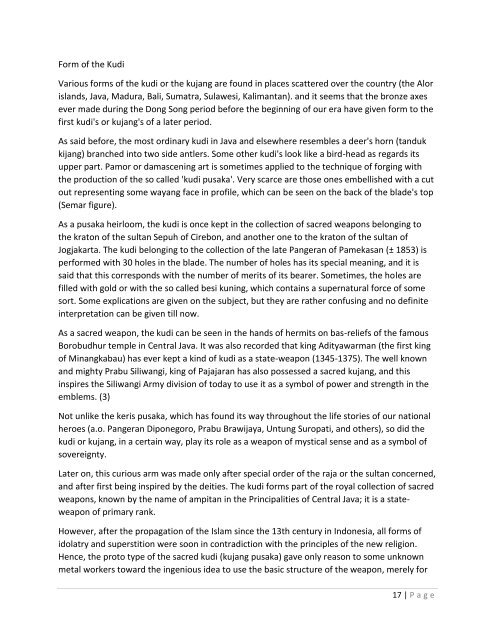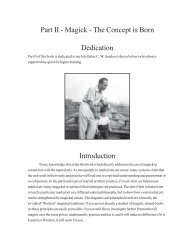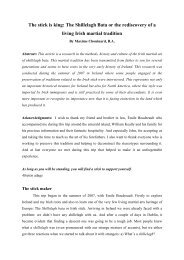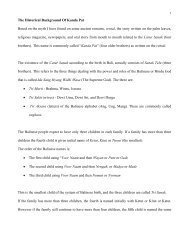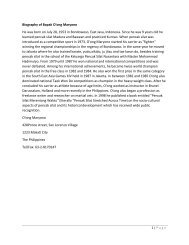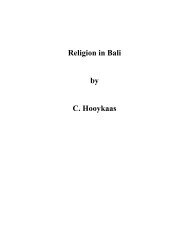The Myth of Maempo Cimande - Pukulan Cimande Pusaka
The Myth of Maempo Cimande - Pukulan Cimande Pusaka
The Myth of Maempo Cimande - Pukulan Cimande Pusaka
Create successful ePaper yourself
Turn your PDF publications into a flip-book with our unique Google optimized e-Paper software.
Form <strong>of</strong> the Kudi<br />
Various forms <strong>of</strong> the kudi or the kujang are found in places scattered over the country (the Alor<br />
islands, Java, Madura, Bali, Sumatra, Sulawesi, Kalimantan). and it seems that the bronze axes<br />
ever made during the Dong Song period before the beginning <strong>of</strong> our era have given form to the<br />
first kudi's or kujang's <strong>of</strong> a later period.<br />
As said before, the most ordinary kudi in Java and elsewhere resembles a deer's horn (tanduk<br />
kijang) branched into two side antlers. Some other kudi's look like a bird-head as regards its<br />
upper part. Pamor or damascening art is sometimes applied to the technique <strong>of</strong> forging with<br />
the production <strong>of</strong> the so called 'kudi pusaka'. Very scarce are those ones embellished with a cut<br />
out representing some wayang face in pr<strong>of</strong>ile, which can be seen on the back <strong>of</strong> the blade's top<br />
(Semar figure).<br />
As a pusaka heirloom, the kudi is once kept in the collection <strong>of</strong> sacred weapons belonging to<br />
the kraton <strong>of</strong> the sultan Sepuh <strong>of</strong> Cirebon, and another one to the kraton <strong>of</strong> the sultan <strong>of</strong><br />
Jogjakarta. <strong>The</strong> kudi belonging to the collection <strong>of</strong> the late Pangeran <strong>of</strong> Pamekasan (± 1853) is<br />
performed with 30 holes in the blade. <strong>The</strong> number <strong>of</strong> holes has its special meaning, and it is<br />
said that this corresponds with the number <strong>of</strong> merits <strong>of</strong> its bearer. Sometimes, the holes are<br />
filled with gold or with the so called besi kuning, which contains a supernatural force <strong>of</strong> some<br />
sort. Some explications are given on the subject, but they are rather confusing and no definite<br />
interpretation can be given till now.<br />
As a sacred weapon, the kudi can be seen in the hands <strong>of</strong> hermits on bas-reliefs <strong>of</strong> the famous<br />
Borobudhur temple in Central Java. It was also recorded that king Adityawarman (the first king<br />
<strong>of</strong> Minangkabau) has ever kept a kind <strong>of</strong> kudi as a state-weapon (1345-1375). <strong>The</strong> well known<br />
and mighty Prabu Siliwangi, king <strong>of</strong> Pajajaran has also possessed a sacred kujang, and this<br />
inspires the Siliwangi Army division <strong>of</strong> today to use it as a symbol <strong>of</strong> power and strength in the<br />
emblems. (3)<br />
Not unlike the keris pusaka, which has found its way throughout the life stories <strong>of</strong> our national<br />
heroes (a.o. Pangeran Diponegoro, Prabu Brawijaya, Untung Suropati, and others), so did the<br />
kudi or kujang, in a certain way, play its role as a weapon <strong>of</strong> mystical sense and as a symbol <strong>of</strong><br />
sovereignty.<br />
Later on, this curious arm was made only after special order <strong>of</strong> the raja or the sultan concerned,<br />
and after first being inspired by the deities. <strong>The</strong> kudi forms part <strong>of</strong> the royal collection <strong>of</strong> sacred<br />
weapons, known by the name <strong>of</strong> ampitan in the Principalities <strong>of</strong> Central Java; it is a stateweapon<br />
<strong>of</strong> primary rank.<br />
However, after the propagation <strong>of</strong> the Islam since the 13th century in Indonesia, all forms <strong>of</strong><br />
idolatry and superstition were soon in contradiction with the principles <strong>of</strong> the new religion.<br />
Hence, the proto type <strong>of</strong> the sacred kudi (kujang pusaka) gave only reason to some unknown<br />
metal workers toward the ingenious idea to use the basic structure <strong>of</strong> the weapon, merely for<br />
17 | P a g e


